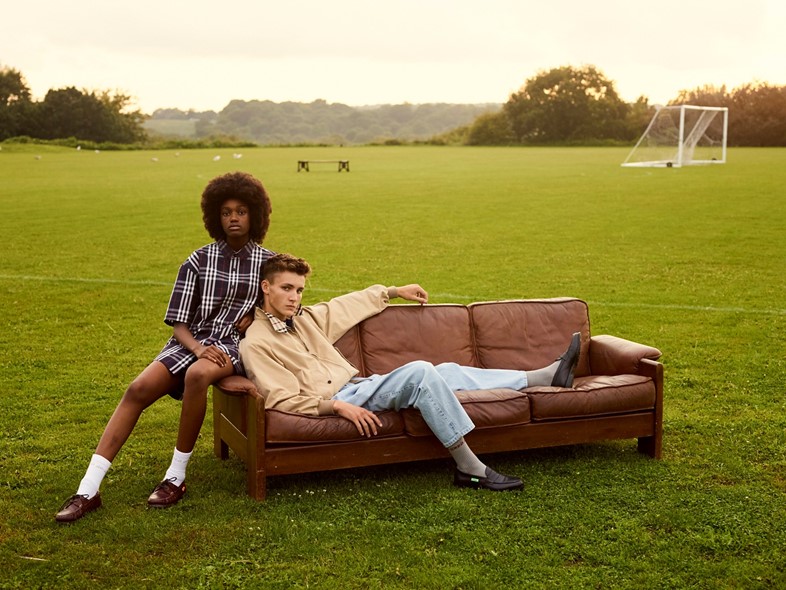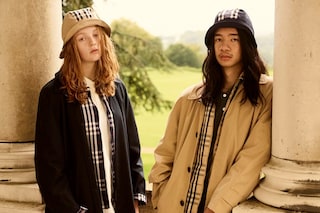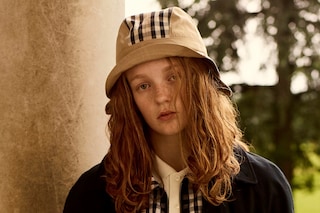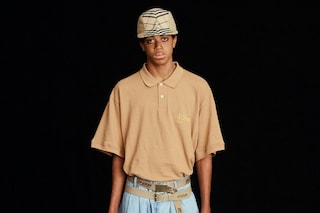We follow the designer from the back room of a St Petersburg club to an exhibition space Old Sessions House, as he opens up about his collaboration with the very British brand
“These walls keep the spirits from the 90s,” declares Gosha Rubchinskiy. It’s about 1am, and the Russian designer is seated in the back room of legendary St Petersburg club Griboedov, founded in 1996 in an old Soviet bunker. Somewhere down a set of stairs, behind a series of metal doors several inches thick, music is pounding – the afterparty of his SS18 show is well underway, and bodies move under the flashing lights. The muffled beat reverberates through the walls of the room, which are papered with old photographs of those original clubgoers.
Rubchinskiy first found himself wandering the venue’s labyrinthine corridors back when he was a teenager, in town on a school trip just a couple of years after it opened. “It was cool in the 90s, I remember it,” he says. “Now the next generation are making it cool again.” For Rubchinskiy, who has managed to integrate references to Alexander Rodchenko and the Paninaro tribe of 80s Milan with contemporary skate style, that sense of an authentic connection between the past and the present is a constant throughout his work.
The evening’s show was no different. It was held in the former Palace of Culture for Communication Workers, an imposing constructivist building on the banks of the River Moyka. But behind its traditional Soviet appearance (a carved hammer and sickle is above the door, and stone statues of three workers mark its facade) is a rich subcultural history – it was there, in 1989, that the city’s first rave took place, organised by artist and cult figure Timur Novikov. “He’s our icon,” says Rubchinskiy, who created a capsule collection featuring motifs from Novikov’s paintings back in 2015.
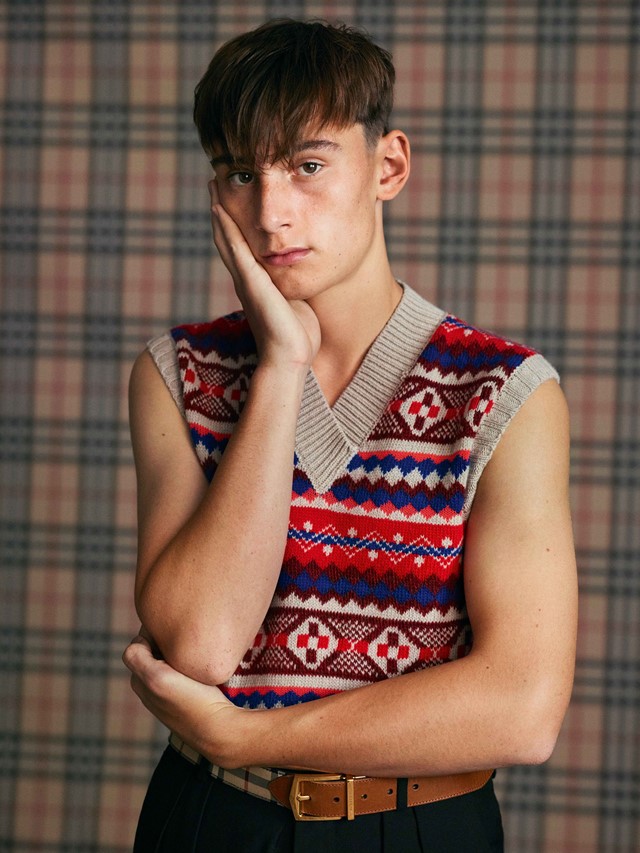
The SS18 collection was directly inspired by the clothes Russia’s first generation of club kids wore. Patterned jumpers and Day-Glo neons jostled with tie-dye, super-wide jeans and branded sportswear, courtesy of Rubchinskiy’s ongoing collaboration with adidas Football ahead of the 2018 World Cup in Russia. But it wasn’t a nostalgia trip – everything was imagined through the sartorial lens of the contemporary skaters Rubchinskiy surrounds himself with, styled with loafers and shades.
And then, there was the utterly unexpected – a head-to-toe look rendered entirely in a pattern no one imagined would appear on the runways anytime soon, Burberry check. Featuring a shirt, shorts and hat designed by the legendary Stephen Jones, the look opened a procession of other outfits which were Gosha takes on Burberry’s heritage, including classic trenchcoats and Harrington jackets.
“I started to think, ‘What was going on in England (during the 90s)? What was the most iconic thing?’ And, of course, it was Burberry” – Gosha Rubchinskiy
Rubchinsky first became familiar with the pattern, unjustly maligned in the UK for its associations with the working class, after seeing it in 90s club features in magazines like The Face. (Russia’s equivalent of the Burberry ‘chav’, the tracksuit-wearing ‘gopnik’, has been another identifiable influence in the designer’s output.) His thought process for bringing it back? “St Petersburg was always like a window into western culture in Russia,” he explains. “So I started to think, ‘What was going on in England (during the 90s)? What was the most iconic thing?’ And, of course, it was Burberry. It worked perfectly with 90s nightclubbing and rave culture.”
For Burberry’s chief creative officer Christopher Bailey, who flew in to see the show, hearing from Rubchinskiy was a welcome surprise; he had long admired the designer’s photography. They worked on the collection over email, without ever having met in person. “It’s something I’ve always been intrigued by, the way that different subcultures adapt and translate different things,” he reflected, musing in St Petersburg on Rubchinskiy’s ability to bring the heritage pattern into his own world – and, presumably, away from the chav-check associations that created an image crisis for the brand in the mid-00s, causing them to cut back on its use. “My grandad wore Burberry, Gosha is intrigued by it, the Queen of England wears it. It talks to people. What is it that can take (the brand) from street subculture to absolute formality and establishment?”
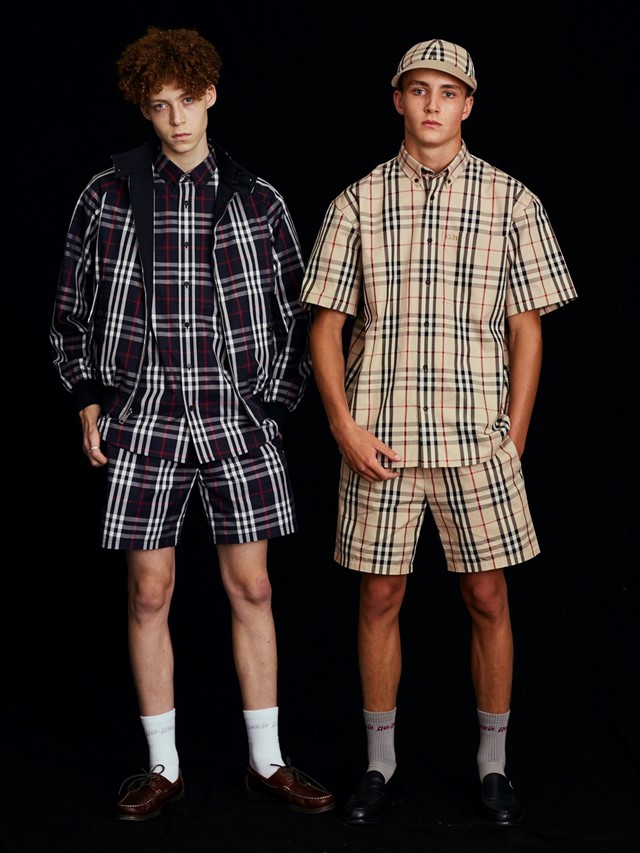
That sense of the street was certainly on Rubchinskiy’s mind – as well as ravers past, he was inspired by the way he’s seen young guys today adopt the infamous pattern. “It can have one image in the UK and a different one in Russia,” he says. “In Russia it’s more about vintage items from second-hand stores. When I’m around my skate friends, they are always wearing some form of vintage Burberry from the 90s.”
In the fashion industry, Rubchinskiy is something of an outlier. He’s skipped the traditional show schedule, his brand has the prestige of being housed under the Comme des Garçons umbrella, and he’s got his own cult following that seemingly backs everything he does. The Gosha effect is real – his collaborations with old-school sportswear brands like Kappa and Fila for SS17 have seen both experience a renaissance. Bailey commends his knack for reinvention: “To take something familiar and reinterpret it to make it feel relevant and contemporary, to feel right and appropriate for a certain moment and time? That’s a real skill.”
“My grandad wore Burberry, Gosha is intrigued by it, the Queen of England wears it. It talks to people. What is it that can take (the brand) from street subculture to absolute formality and establishment?” – Christopher Bailey
It was a skill that Bailey himself drew on for his own show this season, held during London Fashion Week. With Rubchinskiy in the audience, he explored very British touchstones, including plastic macs, tartan capes and yes, heaps of Burberry check. In other words, it returned to reference points that were well known, but presented them in a different, youthful way. “We’re living in a period of such volatility and such change that something familiar is incredibly reassuring,” Bailey explained prophetically, speaking back in Russia. “The reinterpretation of that for the future feels quite uncomfortably soothing.” Backstage, when asked about the inclusion of the check, he continued this train of thought. “I wanted to show it in a new way and have a pride in it.”
Rubchinskiy, too, is clear that what he does – and this latest partnership especially – is not about dwelling on what’s come before. “We don’t want to do a story about heritage – I hate that word,” he says. “I’ve always tried to tell a story about what’s happening now.” That continued after St Petersburg, with Bailey asking him to shoot a series of images to be made into a book and featured in Here We Are, the public exhibition at the Old Sessions House show venue. With models street cast in London and posing in football pitches, Rubchinskiy, surrounded by his images, said that they show the “kids of today”. After all, “If you want to know about a time, you only need to look to the youth.”
